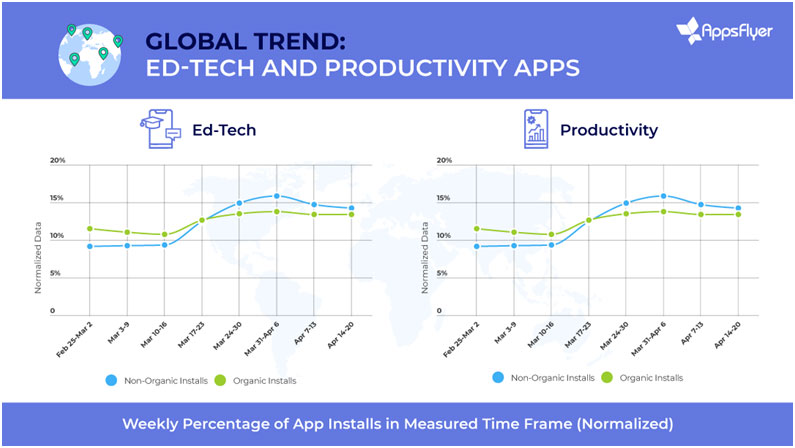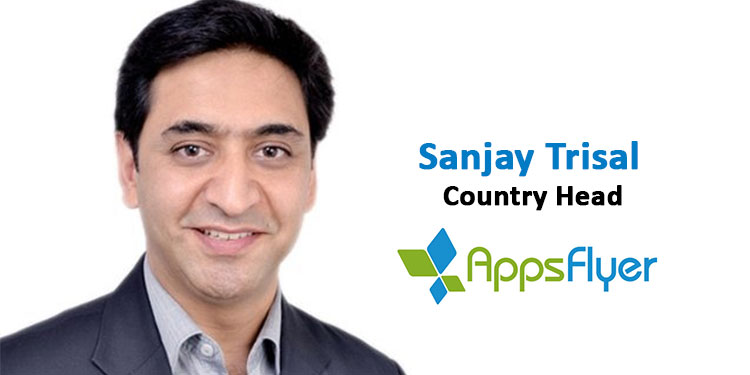The mobile app marketplace during the initial peak of the global pandemic has its fair share of industry-verticals that are: 1) severely impacted (travel & transportation) and, 2) almost instinctively booming (gaming & entertainment).
And there are a few – that at some point in the near past could have easily been considered outliers – that are emerging and flourishing as they bring enhanced value in this “new normal” environment.
As leader of the India business, we have the responsibility of empowering our team into providing unique insights and opportunities for our customers, and their industries at large.
We have become more personally exposed and eventually taken a keener interest in the app categories of education-tech and productivity. With students practicing online schooling via numerous LFH (learn-from-home) apps, adults have also become compelled to improve on their WFH (work-from-home) ways, resulting in high-frequency use of productivity apps and tools.
AppsFlyer’s own data reflects that this growing usage trend is also triggered mainly by increased marketing spend, from the brands themselves.
This realization is based on the gradual but steady rise of non-organic installs in both verticals, starting from late February when governments began imposing stricter lockdowns. As a refresher, a non-organic install is one that attributes a user engaging with a specific stimulus (think: ad, video, QR code, emailer, etc) that results in an app being installed on a mobile device. In essence, a non-organic install is the output of a brand’s marketing investment.

What helps drive this assured uptrend is the practice of what I would refer to as “intelligent remote marketing,” a method of quickly tapping into demand, powered by analytics and insights-scaling, resulting in highly customized messaging and campaigns that are simply, more creative and altruistic than usual.
One of the first regional examples that stood out for us is Ruangguru, a Southeast Asian ed-tech platform recently recognized by the Indonesian president himself for their efforts in championing a more tech-literate society. When coronavirus started becoming a real domestic concern, the startup collaborated with a leading local telco for free online courses via free data. This partnership has opened up opportunities for a more targeted user acquisition, tapping into a segment that they have presumably not focused on before.
Big conferences and product launches for many B2B companies are usually marketing bread and butter, so cancelations are expectedly creating a ripple effect on an otherwise meticulously planned events calendar. Perhaps one of the earliest to have defied cancellations, by swiftly moving their flagship event (called “Momentum) into live streaming, was e-signature company, Docusign. It may not have had a similar experience for attendees, but keeping a strong database ripe for relationship-building and business development remains intact.
And of course, one of India’s largest ed-tech companies, Unacademy, announced in April that they are mobilizing their entire network of educators to offer free online classes for students across various exam categories. The company has been hosting over 700 free live classes a day. Regardless of whether it garners dozens of additional brownie points for brand-building, the move demonstrates a genuine and noble concern for student learning and development in India.
Graphic design platform, Canva, has been rolling out a series of ready-to-publish Instagram templates about coronavirus announcements and related health protocols, injected with the brand’s signature style and quirkiness. These templates are almost perfectly tuned to a small business owner’s design needs, or any person deeming to start an e-commerce project from home. As the ad templates also get retargeted, it is not unlikely that this is being continuously based on informed data decisions around mobile user acquisition.
Coronavirus means many businesses face an uncertain future. Ultimately, at least for mobile marketing, the fundamentals of measuring engagement and spending across the entire funnel will accelerate recovery and sustain industry growth.
For every brand or app that’s hit hard, there’s one or two that are making the most of this crisis and are already solidifying their market share. Discontinuing advertising nor downplaying brand-building efforts are never productive. The intelligent and creative use of remote marketing, powered by a holistic view of every user journey, may as well be the answer.
Authored by Sanjay Trisal, Country Manager, AppsFlyer India.
















